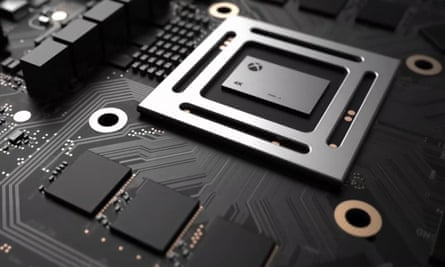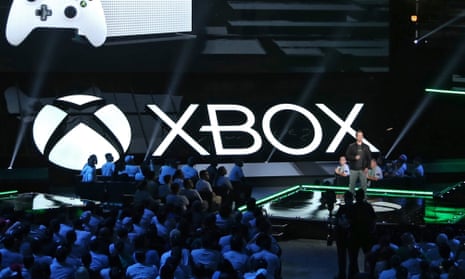Earlier this month, Microsoft did something console manufacturers haven’t done for many years. It announced key details of its forthcoming Project Scorpio console – an update to the Xbox One – via a set of exclusive features on the video game news site, Eurogamer. In the modern games industry the strict control of information, especially regarding hardware, has become something of a corporate obsession. To cede control of a major revelation – in this case the technical specifications of a forthcoming machine – was a fascinating, but intelligent move. It added a sense of impartiality and validity to all the specs and stats that came out of the reveal, lending the information some real authority that would have been missing from an official press release. It let gamers start processing the meaning of the machine for themselves.
But there are still big questions for Microsoft: Is there really a large enough audience for a high-powered version of a console that’s barely three years into its lifecycle? Is this really just about the 4K television industry?
To understand Scorpio, you have to look at what’s happened to Microsoft since the launch of the Xbox 360, a decade ago. That machine was a revelation – powerful, innovative and sporting the best console multiplayer infrastructure around. But in this generation, from the infamous unveiling of the Xbox One (and the pounding Sony gave the machine at E3) to the huge sales of the PlayStation 4, Microsoft has been playing catch-up. Scorpio is very much a full-stop on that – it’s an attempt to reclaim the innovative and technological high ground.
Officially announced at the E3 games conference last June, Project Scorpio is an impressively powerful new version of the Xbox One, due out this Christmas. Featuring eight custom x86 cores clocked at 2.3GHz, a 1172MHz graphics processor and 12GB of system memory, it adds considerably to the original machine’s processing power and graphics capabilities. It will, in theory, allow native 4K resolution gaming, at 60 frames-per-second, and with full support for HDR colour – and in terms of processing grunt, it is set to considerably out-perform Sony’s PlayStation 4 Pro. Developers will still need to support the standard Xbox One and Xbox One S iterations with every game they make, but from now on they’ll have the option of supporting the high-end visual feature-set of this new machine.
One thing that some gamers immediately picked up on about the new machine specifications however is that it has stuck with AMD’s Jaguar class of processor, which powered the original Xbox One, as well as the PlayStation 4. It’s been highly augmented and customised for Scorpio, but Microsoft hasn’t swapped out the silicon for a newer more powerful processor family.
For the head of Xbox, Phil Spencer, this is part of the price/performance compromise that characterises the console industry. “If you said to me, ‘could you or another console manufacturer design a $2,000 console that ran, like, two Titan Xs SLI-d together?’ Then yeah, we could do it. But the console price points aren’t there. If you’re willing to spend a couple of grand building up an i7-based machine with umpteen terabytes of RAM, you can go do that on a PC. But I actually feel with Scorpio we’ve been able to hit a really nice price/performance ratio. When we talk about the price, I think people will see that. It is a premium product, there’s no doubt, but I think relative to the PC that you could go buy at this spec, you’re gonna feel really good.”
He’s still not talking about price (or the final name of the machine), but current conjecture is $499/£499, and that would certainly fit with his idea of Project Scorpio as a ‘premium’ machine that’s not priced massively outside of the console space. The big question though is – who will buy Scorpio? Who is it for? The Xbox One S, released last August upgrades the original console by offering HDR capabilities, 4K video playback and upscaled game visuals, which for a lot of people – is enough. Titles like Forza Horizon 3 and Gears of War 4 already look amazing on 4K televisions. Also, a majority of gamers are yet to make the switch to 4K sets.

For Spencer, though, Scorpio isn’t exclusively a 4K proposition: according to Microsoft, the console will make use of its improved rendering and processing power to improve the frame rates and general visual performance of games, even when viewed on a 1080p screen. In effect, current Xbox One games that use dynamic resolution scaling (ie they have the ability to output visuals at higher resolutions when the hardware allows) will exploit the Scorpio’s power to improve the graphical performance on 1080p, while any titles released later to specifically target 4K, will also super-sample down for 1080p displays so that those owners get some of the benefits, including improved anti-aliasing and texture filtering.
“I think Scorpio is for the console customer who wants the best version of the console games on their television, whether they have a 1080p or a 4K television,” he says. “We’ve got a higher frequency CPU than any other console, we’ve got a better GPU, we’ve got more RAM. I have a Scorpio at home, so I’ve moved it back and forth from a 1080p TV to a 4K TV – and if you’re running on a 1080p TV and you plug Scorpio in you’re gonna be able to tell. I can tell.”
So does this mean we’re going to get smooth frame rates and draw distance on titles like Witcher 3, which push current hardware to its limits? “We took a distinctive approach with Scorpio to say we want all games to run well,” says Spencer. “Every game should get access to the full capabilities of the hardware, whether the game was written two years ago for Xbox One, 10 years ago for 360, or is yet to be shipped. You’re gonna see games that shipped on Xbox One that just natively run better on Scorpio, because you have the CPU and GPU power, and things like scalable resolution, which Halo used. You’re just gonna find that it’s running at a higher resolution a lot of the time, or all the time – and if the team does specific work for Scorpio obviously then there’s a ton of headroom to go do something great.”
According to Spencer a key aim has been to give developers the options to support Scorpio the way they want – and Microsoft is therefore guarded about setting performance targets. However, in a recent interview with Gamasutra, Spencer mentioned a specific benchmark for Scorpio titles: native 4K resolution, 30 frames-per-second. How did that figure come about? “We looked at games on Xbox One that were running at 30-frames-per-second in 1080p, or sometimes 900p, and we said, ‘If you’re running at 1080 30 on Xbox, we want to make sure that we give you the hardware capability to run at 30 in 4K’,” he says. “The only reason I focused on 30fps is because we have a lot of those on Xbox One.
“But we’re not dictating that that’s what developers do. They can make other decisions with resolution and framerate, and the Forza stuff we have shown was running at 60fps, 4K. You’ll have people who do that, and you’ll have people who’ll make decisions to do less than a native 4K frame buffer.”
“When developers come into the labs and port their engines over to Scorpio, we say, ‘Hey, start with your high-end PC settings, and then see what happens’. We’ve been really pleasantly surprised by the results, because you don’t know what’s gonna happen when you start running third-party engines.”

Spencer won’t be drawn on the ratio of Xbox developers who are specifically targeting Scorpio-level capabilities, v the number who simply plan to add the most rudimentary support for the hardware in their forthcoming releases. But he’s realistic about it. “Teams will target big market segments,” he says. “The largest installed base will be Xbox One, for us, right, and they’re gonna want to sell to that. The difference, though, is that it’s the Scorpio customer that buys the most games. So teams may say ‘Hey, I’m just gonna do an Xbox One version of the game, and it’ll run better in Scorpio but I’m not gonna do anything specific to take advantage of Scorpio beyond just what I get from CPU and GPU,’ and you’ll have other teams that say, ‘I know my customer is the Scorpio customer’. I always want to give the tools to the creatives and let them make the decisions.”
When pushed on how far developers will be able to take their specialist support of Scorpio, Spencer is also ambiguous. With the extra RAM and processing power, it may be possible for some teams to add extra gameplay content only accessible to Scorpio owners. This, he says, hasn’t been broached yet – but again, he’s preaching flexibility, and an openness to what the creatives want to do. “These are decisions I think it’s better for us to make in the context of specific game ideas that people have,” he says. “We’re in constant dialogue with developers about the ways they would like to exploit the Scorpio hardware. All of the ideas teams have come back with today are about how to make the game feel and look better on Scorpio. We haven’t had many people that have wanted to create a gameplay difference.”
In effect, Scorpio is doing the same job as PlayStation 4 Pro. Both are recognitions of the fact that 4K screens are now selling in larger and larger numbers and that these consoles have to support the market surge. But while PlayStation 4 Pro, which came out in November, offers a slightly compromised vision of the native 4K experience, Scorpio is a powerful, intricately designed upgrade. It is, perhaps, the Samsung Galaxy S8 to Sony’s iPhone 7; the Sennheiser Momentum to Apple’s Beats – we’ll have to judge it when it arrives. For now, what it very much is, is a statement of intent.
“Three years ago we were in a position where maybe our hardware wasn’t touted as the best in the market,” says Spencer. “Now I can say, OK, from the Xbox One S to Scorpio, I’m incredibly proud of our hardware lineup relative to anybody else’s.” Xbox One has lagged behind PlayStation 4 in many respects - now we may be about to feel the sting in its tail.

Comments (…)
Sign in or create your Guardian account to join the discussion